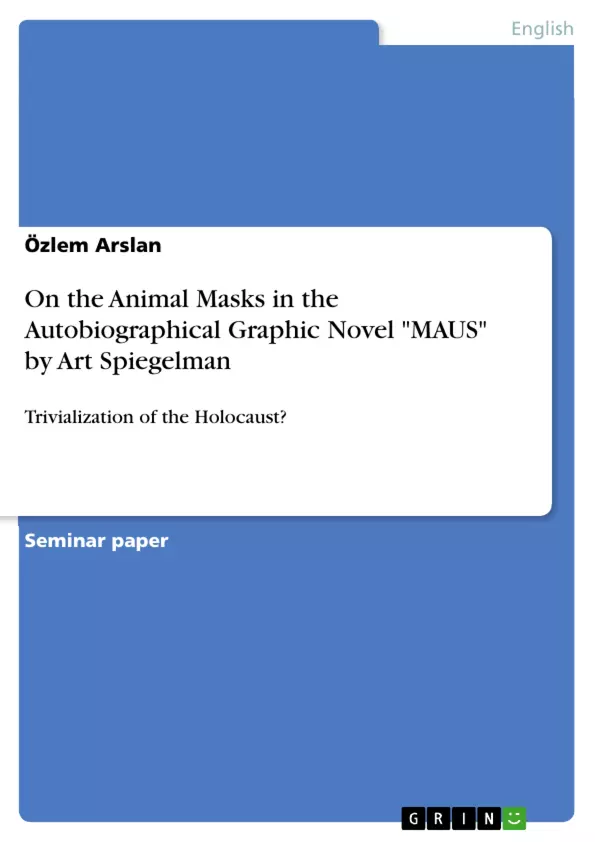This term paper aims to examine the function of the animal masks in Art Spiegelman’s graphic novel "Maus" with the question in mind whether it trivializes the Holocaust or not. The paper will begin with an introduction to the different types of animal heads and the possible reasons for the choice of the artist by giving some historical background. The main part will discuss the use of the animal masks and its functions by analyzing significant panels from "MAUS". Finally, the paper will also contain a conclusion in which the results will be summarized.
"MAUS" is an autobiographically written graphic novel by Art Spiegelman which consists of two parts, "Maus I" (1986) and "Maus II" (1992), and tells the story of the artist’s parents, Anja and Vladek, who survived the Holocaust and the reader also gets a view on the afterlife of Vladek and his relationship with his son "Artie".
Art Spiegelman received a lot of praise and was celebrated in the press for his work. Amongst other achievements, he was honored with the Pulitzer Prize for "MAUS" in 1992. However, his graphic novel was also criticized for the use of animal masks for the characters. To elaborate on this, Spiegelman chose to depict the affiliation to a religion or culture of characters by using animal make in the past and present time of the graphic novel. For example, cats for Germans, mice for Jews and pigs for Poles. Especially the representation of Jews as mice and Poles as pigs caused many negative critiques from Jewish and Polish people themselves. Furthermore, Spiegelman’s presentation method was criticized for naturalizing something unnatural, which means it was perceived as trivializing the Holocaust and by that insulting the victims. Even though the use of animal masks was criticized for in a way trivializing the Holocaust, one could also argue that the animal heads function as a medium to demonstrate the racist ideology of the Nazis and the hierarchies during that time. In addition, one could also argue that the presence of the animal heads in the present time of the graphic novel indicate the effects and consequences for the persons related after the Holocaust. These different perspectives on this topic raised the question of whether the graphic novel really trivializes the Holocaust or not.
Table of Contents
- Introduction
- The Animal Masks in Art Spiegelman's Maus
- Function and Effect of Cat, Mice, Pigs and other Animal Masks
- The Masks in Past and Present Time in Maus
- Conclusion
- Works Cited
Objectives and Key Themes
This paper examines the use of animal masks in Art Spiegelman's graphic novel MAUS, specifically addressing the question of whether their use trivializes the Holocaust. The paper analyzes the function of the different animal masks and explores the historical context surrounding their choice.
- The function and effect of animal masks in depicting different nationalities and cultural affiliations
- The historical context of antisemitism and its role in the Holocaust
- The potential for animal masks to trivialize or dehumanize the victims of the Holocaust
- The impact of the animal masks on the narrative and the reader's understanding of the Holocaust
- The use of animal masks as a way to represent the consequences of the Holocaust for survivors
Chapter Summaries
- Introduction: Introduces the topic of the animal masks in MAUS, highlighting the controversy surrounding their use. The introduction establishes the paper's objective, which is to examine the function of the animal masks and their potential to trivialize the Holocaust.
- The Animal Masks in Art Spiegelman's Maus: This chapter delves into the rationale behind Spiegelman's choice to depict characters using animal masks. It explores the historical context of antisemitism and the Holocaust, highlighting the role of different nations in these events. The chapter also analyzes the different types of animal masks used in the graphic novel and the significance of their choice.
Keywords
The primary keywords and focus topics of the text include: MAUS, Art Spiegelman, Holocaust, animal masks, antisemitism, representation, trivialization, dehumanization, historical context, cultural affiliation, narrative, consequences, survivor, Jewish identity, Polish identity, German identity.
- Citar trabajo
- Özlem Arslan (Autor), 2019, On the Animal Masks in the Autobiographical Graphic Novel "MAUS" by Art Spiegelman, Múnich, GRIN Verlag, https://www.grin.com/document/495728



